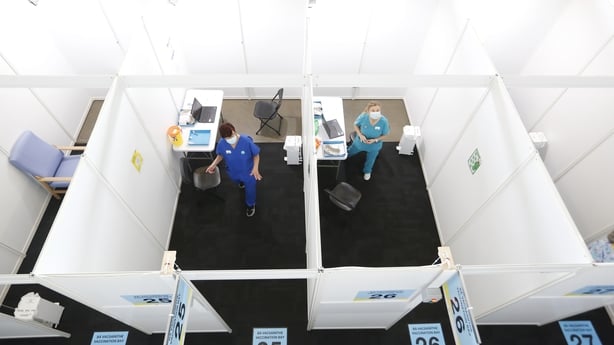The National Immunisation Advisory Committee (NIAC) has made a key decision on the Johnson & Johnson vaccine – and has once again changed its advice on the AstraZeneca vaccine.
Whether it's good news or bad news depends on the position you start from.
In light of the pause of the roll-out of the Johnson & Johnson vaccine, the HSE has been operating on the basis that it would not return.
From that perspective, it’s positive news that NIAC is advising that it can be used to vaccinate those over the age of 50 and those in hard-to-reach communities.
But the targets were set based on its full availability. In February, the Taoiseach said 55% of adults should be fully vaccinated by the end of June.
It appears the NIAC advice will make achieving that more difficult, in that significant limits have been placed on who can get the vaccine.
The two shifts are undoubtedly going to impact the vaccine roll-out. But will they push the date back, or bring it forward?
Right now, it’s hard to know. The Government also said on Tuesday that people under the age of 50 who had Covid-19 in the previous six months will only need one vaccine dose to be considered fully vaccinated.
Currently, the HSE is trying to figure out ways to adjust the roll-out to accommodate the NIAC advice.
What we do know is that the pace of the vaccine roll-out has been improving.
There has been a major up-tick in the number of doses administered in the past 10 days. Some 190,000 doses were dolled out over the last week.
We need your consent to load this Datawrapper contentWe use Datawrapper to manage extra content that can set cookies on your device and collect data about your activity. Please review their details and accept them to load the content.Manage Preferences
However, if the vaccine roll-out were on track, we should be doing about 250,000 doses right now.
At the current pace, we’re set to hit that number around 12 May. By that measure, we’re around two weeks off track.
While today’s new upheaval won’t help, it still appears just about possible for the roll-out to catch up – and get closer to where we need to be by the end of June.
By then, the aim is that both 55% of adults will be fully vaccinated – and 82% of adults will have received one dose.
To get there, we’d need to be administering around 450,000 doses per week by the middle of June.
Despite the changes, the 82% target appears just about doable. But achieving the 55% fully vaccinated target would require using nearly all of the Johnson & Johnson doses that are due to arrive in the country by the end of June.
And that’s where the NIAC advice could cause a problem for the roll-out.
The only major cohort remaining that can receive the Johnson & Johnson vaccine is those aged 50 to 59.
There are about 500,000 of them, and they had been due to get appointments between 17 May and 31 May.
The vast bulk of the Johnson & Johnson doses aren’t expected until June, with only 160,000 doses due to arrive before 31 May.
As such, the decision appears to create a dilemma for the roll-out.
They need to use all of the Johnson & Johnson doses to hit the targets. But the 50–59s are next in line.
And on current schedules, there won’t be enough Johnson & Johnson vaccines available to give to them when their appointments were meant to come due.

So do they give 50–59s whatever vaccine is available – which includes AstraZeneca – and complete all their appointments in late May as planned, or do they make the people in their 50s wait for the Johnson & Johnson deliveries, and in the meantime, accelerate younger age cohorts?
Put yourself in their shoes: If you go with the first option and give 50–59s whatever vaccines are available in late May, you would partially protect them sooner.
But could end up with leftover Johnson & Johnson doses in late June, at which point there’d be no one over 50 left to receive a vaccine who could still actually have them.
If you choose the second option, it would mean that all of the Johnson & Johnson doses are used, and that far more people end up being fully vaccinated by the end of June.
Yet it would also mean that many in the 50–59 age cohort would, for several more weeks than currently planned, be lacking the protection that one vaccine dose would offer them between mid-May and mid-June.
But, since they would be holding out for the single-dose Johnson & Johnson vaccine, they would be fully protected once they get it some time in June.
In other words, it seems, you can ask the 50–59-year-olds to wait, or you can risk wasting Johnson & Johnson doses.
It’s not an easy or clear choice, and other solutions may arise. But what is clear is that the NIAC advice presents another headache for those in charge of our vaccine roll-out.






